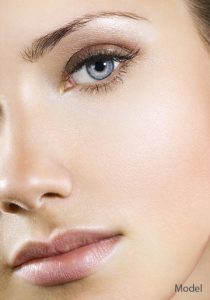 Asian eyelid surgery, also known as double eyelid surgery, is a popular cosmetic procedure that aims to create a natural-looking crease in the eyelid for individuals of Asian descent. This procedure can enhance the appearance of the eyes, making them appear larger and more defined. If you are considering Asian eyelid surgery, it is important to choose a skilled oculoplastic surgeon who specializes in this specific type of procedure. In this blog post, we will take a deep dive into Asian eyelid surgery, covering everything from the basics of the procedure to what to expect during the recovery process. Khan Eyelid and Facial Aesthetics, led by oculoplastic and reconstructive surgeon Dr. Tanya Khan, provides asian eyelid surgery to patients in Plano, Dallas, Austin, Texas, and surrounding locations.
Asian eyelid surgery, also known as double eyelid surgery, is a popular cosmetic procedure that aims to create a natural-looking crease in the eyelid for individuals of Asian descent. This procedure can enhance the appearance of the eyes, making them appear larger and more defined. If you are considering Asian eyelid surgery, it is important to choose a skilled oculoplastic surgeon who specializes in this specific type of procedure. In this blog post, we will take a deep dive into Asian eyelid surgery, covering everything from the basics of the procedure to what to expect during the recovery process. Khan Eyelid and Facial Aesthetics, led by oculoplastic and reconstructive surgeon Dr. Tanya Khan, provides asian eyelid surgery to patients in Plano, Dallas, Austin, Texas, and surrounding locations.
Understanding the Basics of Asian Eyelid Surgery
Asian eyelid surgery, a transformative cosmetic procedure, is meticulously designed to introduce a crease into the eyelids of individuals of Asian heritage who naturally lack one. This surgical intervention not only augments the aesthetic appeal of the eyes by making them seem larger but also crafts a more pronounced eyelid contour, enhancing the overall facial symmetry and balance. The essence of this procedure lies in its ability to tailor the eyelid’s appearance to meet the unique desires and anatomical needs of each patient, thereby ensuring a personalized and natural outcome.
The procedural techniques for achieving these results are broadly categorized into the incision and non-incision methods. The incision method involves a surgical approach where a precise incision is made along the eyelid to establish a permanent crease. This technique is typically recommended for those with a more considerable amount of eyelid skin or patients who are seeking a noticeable change in their eyelid structure. The meticulous nature of this method allows for the removal or repositioning of fat and tissue, thereby offering a more defined and lasting crease.
On the other hand, the non-incision method provides a less invasive alternative, employing specialized sutures to effectuate a crease without necessitating skin removal. This technique is particularly advantageous for individuals with thinner eyelid skin or those aiming for a subtler enhancement. By strategically placing fine sutures within the eyelid, this method simulates the presence of a crease, yielding a refreshed and rejuvenated eye appearance.
Both approaches require a profound understanding of the unique anatomical considerations of Asian eyelids, including skin thickness, fat distribution, and muscle dynamics. Therefore, selecting a procedure is a collaborative process between the patient and the surgeon, taking into account the individual’s aesthetic goals, eyelid anatomy, and the potential for natural-looking, harmonious results.
The decision between these two methods hinges on various factors, including the desired outcome, the patient’s lifestyle, and the inherent characteristics of their eyelids. Each technique offers its own set of advantages, and understanding these can help individuals make informed decisions about which path might best achieve their vision for enhanced eyelid aesthetics.
Choosing the Right Oculoplastic Surgeon for Your Surgery
Identifying a qualified oculoplastic surgeon with the requisite expertise in Asian eyelid surgery is a critical step in your journey towards achieving your aesthetic goals. The success of your procedure hinges significantly on the skill and experience of your surgeon, hence the importance of thorough research and careful selection cannot be overstressed.
Begin by seeking a board-certified oculoplastic surgeon. Certification is a testament to the surgeon’s dedication to their craft, indicating that they have met the rigorous standards of education, training, and ethical practice set by the governing board. It assures you that the surgeon is not only qualified but also committed to ongoing education and adhering to the highest standards of patient care.
Experience in performing Asian eyelid surgeries is another crucial criterion. This procedure requires not just technical skill but also an artistic eye and a deep understanding of the unique anatomical features of Asian eyelids. A surgeon who specializes in this area is likely to have honed their technique over numerous procedures, thus improving their ability to deliver natural-looking and harmonious results.
During your initial consultation, do not hesitate to inquire about the surgeon’s experience specifically related to Asian eyelid surgery. Ask how many procedures they have performed and request to see a portfolio of before-and-after photos of previous patients. These photos can provide valuable insights into the surgeon’s aesthetic style and the kind of results they are capable of achieving. They can also help set realistic expectations for your own surgical outcome.
Another aspect to consider is the surgeon’s approach to patient care. Opt for a surgeon who listens attentively to your concerns, understands your aesthetic vision, and demonstrates a willingness to tailor the procedure to meet your specific needs. The ideal surgeon should make you feel comfortable, supported, and confident in your decision to undergo surgery.
Lastly, consider seeking recommendations from former patients or consulting trusted medical referral sources. Personal testimonials and referrals can provide an added layer of assurance in the surgeon’s capabilities and professionalism.
Choosing the right oculoplastic surgeon is a deeply personal decision that will significantly impact your surgical experience and satisfaction with the final results. Taking the time to find a surgeon who meets these criteria can make all the difference in achieving the outcomes you desire.
Preparing for Asian Eyelid Surgery
As you move closer to your Asian eyelid surgery date, preparation is key to ensuring a seamless experience and optimal outcomes. Your oculoplastic surgeon will offer a comprehensive guide tailored to your specific case. This preparation phase is an integral part of the journey, designed to prime your body for surgery and recovery.
An essential step in your preparation will involve a detailed discussion about any medications you are currently taking. Certain medications, such as aspirin or anti-inflammatory drugs, can increase bleeding risks and may need to be discontinued well ahead of the procedure. Additionally, supplements and herbal remedies should also be discussed, as some can have similar effects to medications.
Lifestyle adjustments play a crucial role in your preparation. If you are a smoker, you will be advised to stop smoking well in advance of your surgery date. Smoking can significantly hinder the healing process by impairing blood flow, leading to prolonged recovery times and potentially compromising the surgical results.
Nutrition is another critical aspect to consider. Ensuring your body is well-nourished with a balanced diet can aid in recovery. Some surgeons might recommend increasing intake of certain vitamins and minerals, such as vitamin C, to bolster your immune system. However, it’s crucial to discuss and confirm any dietary changes or supplements with your surgeon first to avoid any adverse effects.
Logistics on the day of your procedure should also be arranged beforehand. Organize for a trusted friend or family member to drive you to and from the surgical center. Since you’ll be under the effects of anesthesia, operating a vehicle will not be safe, and having someone to assist you post-surgery can provide both convenience and comfort.
Lastly, setting up a comfortable recovery area at home prior to your surgery can make a significant difference. Have essentials within easy reach, such as medications, water, and light snacks, and prepare a restful space where you can relax without unnecessary strain during the initial stages of recovery.
Following these preparatory steps closely and maintaining open communication with your oculoplastic surgeon can significantly enhance your comfort, safety, and the overall success of your Asian eyelid surgery.
What to Expect During the Recovery Process
The period following Asian eyelid surgery is characterized by a healing process that involves both physical changes and care routines to ensure optimal outcomes. Initially, patients might notice swelling and some degree of bruising in the area surrounding the eyes, which are common effects of the procedure. These symptoms are temporary and should gradually diminish over the days following the surgery.
To mitigate any discomfort during this time, your surgeon may prescribe medication. Adhering to these instructions, as well as the comprehensive post-operative care guidelines provided, is paramount for a smooth and effective recovery. It’s also beneficial to apply cold compresses, as recommended by your surgeon, to help reduce swelling and provide relief.
Recovery times can vary from one individual to another, but many patients find they can resume work and other daily activities within a week, taking care to avoid strenuous tasks that may strain the eyes or elevate blood pressure. While the initial recovery is relatively quick, allowing the final results to emerge can take a bit longer. Swelling may persist for several weeks, gradually revealing the new eyelid crease’s appearance.
Follow-up care is a crucial aspect of the recovery journey. Your surgeon will schedule appointments to monitor the healing progress, make adjustments if necessary, and ensure that the recovery is proceeding as expected. These check-ups are an opportunity to address any questions or concerns that may arise post-surgery.
To support the healing process, patients are advised to protect their eyes from direct sunlight and avoid any activities that could impact the recovery, such as rubbing the eyes or wearing contact lenses too soon. By following your surgeon’s advice closely and maintaining a healthy lifestyle, you can contribute significantly to achieving the desired aesthetic outcomes and enjoying the full benefits of your Asian eyelid surgery.
CONTACT Khan Eyelid and Facial Aesthetics AND OCULOPLASTIC & RECONSTRUCTIVE SURGEON DR. TANYA KHAN TODAY TO SCHEDULE AN APPOINTMENT
For more information about procedures and treatments at Khan Eyelid and Facial Aesthetics by Ophthalmic surgeon Dr. Tanya Khan. Click here to contact us.
Taking patients from in and around Dallas, Plano, Fort Worth, Grapevine, Garland, Mesquite, Carrollton, Irving, Frisco, Texas and more.


 If you are experiencing
If you are experiencing 






Schedule a Consultation: 972-EYE-LIDS (393-5437)